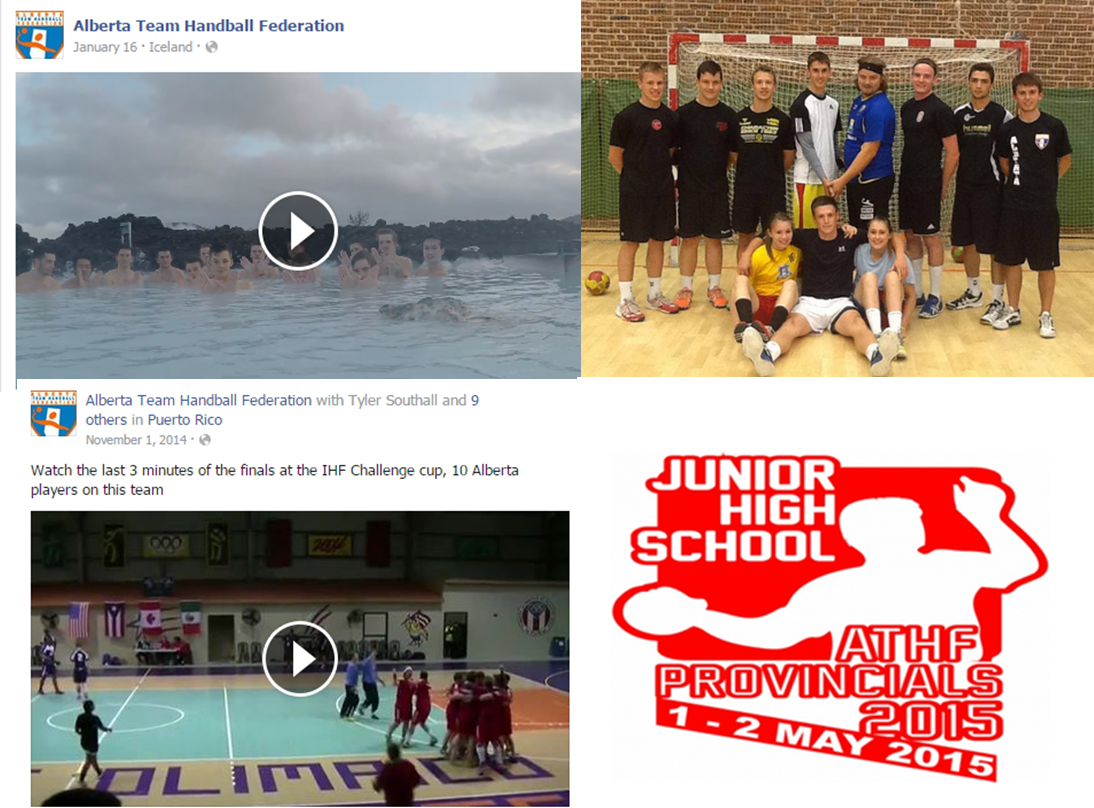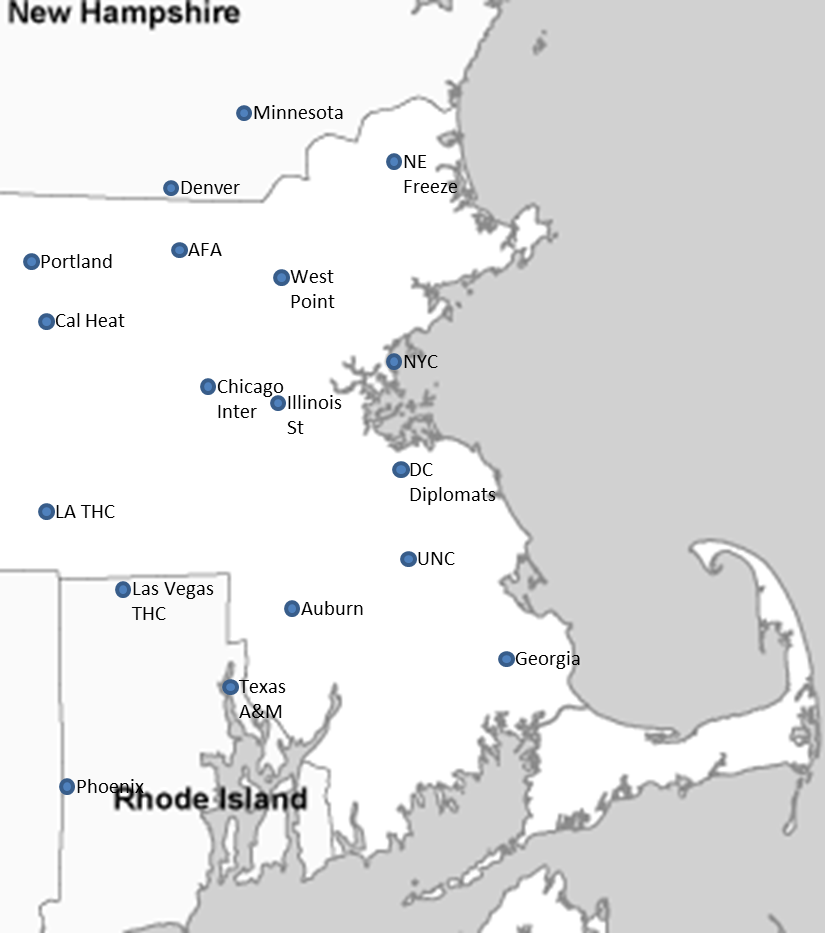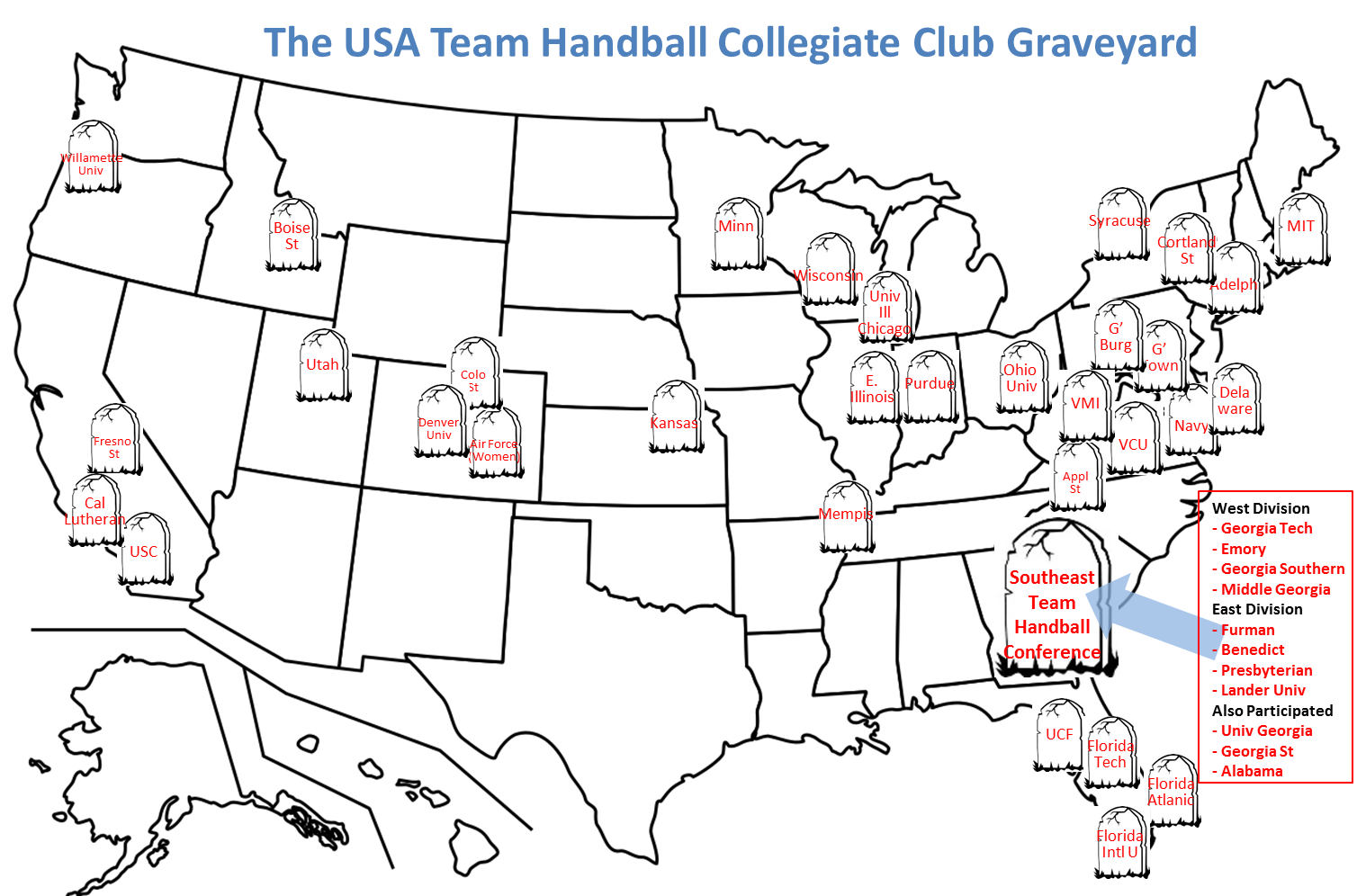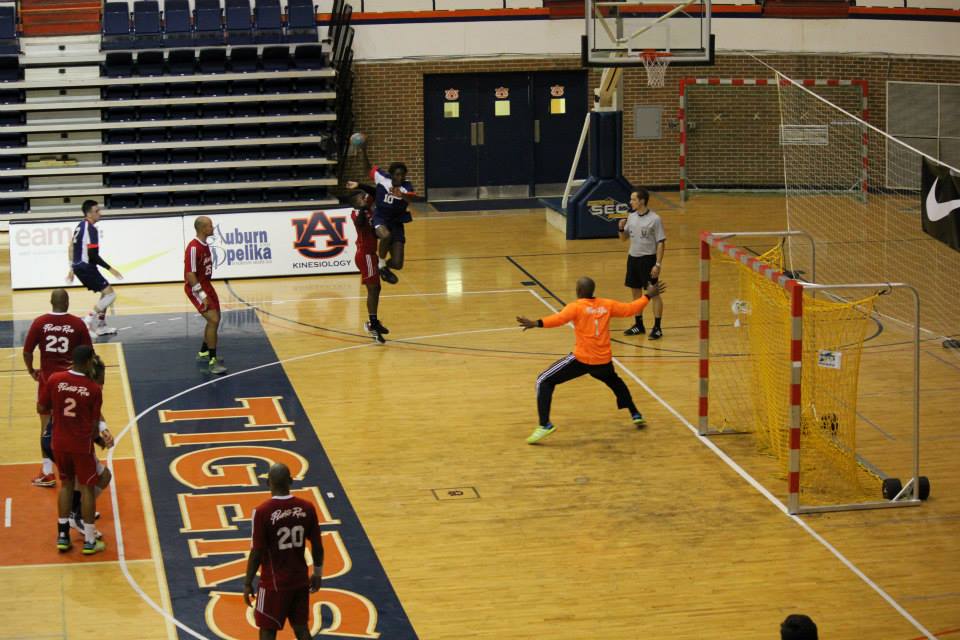
UNC Team Handball: USA Team Handball’s #1 Collegiate Club Success Story as it relates to sustainment. How can more Carolina Handball clubs be created and sustained?
Part 1 for this option provided some background on the state of collegiate handball in the U.S. Part 2 takes a closer look at U.S. Collegiate Rugby, the UNC Handball program and how some of their successes might be more broadly applied to U.S. Collegiate Team Handball.
In the Facebook replies regarding the first part of this discussion on collegiate handball it was pointed out that collegiate programs were very susceptible to faltering because by their very nature college teams are transient with players always departing upon graduation. While this is true, it fails to recognize that this is a problem that is overcome by hundreds of rugby clubs and yes, a handful of team handball clubs, like AF, West Point and the University of North Carolina.
Why Rugby is thriving
No analogy is perfect, but one has to only look at collegiate rugby for a glimpse of what could be. From coast to coast there are 900 collegiate rugby clubs. Not every U.S. college has a rugby team, but almost every NCAA Division 1 school does and sizable portion of the Division 2 and Division 3 schools. Somehow, instead of moving to a collegiate rugby graveyard the vast majority of rugby clubs are surviving and indeed, thriving. How is this being accomplished for collegiate rugby and how might it be duplicated for team handball.
To better understand why rugby is thriving I interviewed Bruce McLane who coaches the Iona Rugby Club and discussed some of the aspects that have over several decades facilitated rugby’s sustainable success.
Here are some of those reasons:
- The number of collegiate rugby clubs has reached critical mass in just about every region of the country. And by critical mass, I mean that just about every collegiate club has relatively close by opponents that they can compete against. This fosters league play, rivalries and competition.
- Rugby clubs have taken the camaraderie aspect of their sport to the highest levels. The days of the beer soaked after party are long gone, but collegiate rugby clubs are still tight knit with alumni often playing a big role in helping to ensure club sustainment.
- Most rugby clubs have been around for decades and in the case of some clubs over a century! Not surprisingly such heritage results in entrenchment that’s pretty hard to dislodge.
Collegiate Handball’s #1 Sustainment Success Story: Carolina Handball
As I wrote in part 1, there are only a handful of clubs that are entrenched in the manner of a club rugby program. Air Force and West Point have been around for decades and have some distinct advantages related to their service academy status, so it would probably take an earthquake of circumstances to envision either program shutting down. Since I started playing handball some 28 years ago there’s only been 3 college programs that I’ve assessed as becoming “firmly established”: Texas A&M’s men program and the Men’s and Women’s programs at the University of North Carolina. And while Texas A&M meets my artificial 5 year requirement few would argue against UNC being the real success story. With so many other programs having fallen by the wayside, it really begs the question, “What has UNC done differently?” And, more importantly, “How could it be duplicated with other colleges?”
To a great extent UNC’s success can largely be attributed to the long term dedication of John Silva. He started the program and provided a guiding hand for well over a decade. This continuity allowed the program to get firmly established and perhaps weather any lean years that inevitably happen after the initial energy of getting started wears off. Most likely his official capacity as a member of the UNC Faculty also facilitated his efforts in recruitment and in the securing of school facilities for practice.
But, probably Silva’s greatest achievement and the reason why UNC is still a thriving club was his foresight and success in mentoring and guiding several individuals like Miles Bacon and Wade Sutton to step into club leadership roles. As such there is now a solid cadre of individuals that makes it pretty unlikely that UNC will be joining the graveyard of clubs any time soon. A legitimate women’s club has even been started and looks to be sticking around! Such mentoring and handing off is always easier said then done. Too many times in the past clubs have disappeared when the “key individual” departs the scene for whatever reason.
A Big Shortcoming (The Failure to Expand the Base of Established Clubs)
While, it’s fair to toot the horns of North Carolina, West Point and Air Force for setting the example it’s also fair to provide some criticism to those clubs and USA Team Handball for failing to expand the base. Let’s face it: it’s pretty boring to see the same 3 clubs year in and year out finishing in the top 3 while other clubs come and go without even coming close to threatening that hegemony.
While these clubs surely take pride in their dominance, they also inherently know that their success is largely due to the lack of strong competition. It’s one thing to say you’re the best out of 10 schools and another thing entirely to say you’re the best out of a 100 or 200.
To a great extent those 3 schools can rightly say, “Hey, it’s not our job to expand the base, that’s USA Team Handball’s responsibility.” A very true statement, but the Big 3 could clearly do more. In particular, I’ll chastise both Air Force and Army for failing to start a sustainable program at Annapolis. There cannot possibly be a more ideal institution/situation to start a program: Link (What an epic failure of those schools and their alumni. (Yeah: I did just call in an airstrike on myself.) Meanwhile, North Carolina appears content for the most part to schedule their annual tournaments and have teams fly in or drive long distances while several relatively nearby colleges remain devoid of the sport.
Options for USA Team Handball Consideration
But, again to be fair the institution most responsible and quite frankly the one that would most benefit from a broader base of U.S. collegiate clubs is USA Team Handball. What could USA Team Handball do bolster USA Collegiate Handball? Here are some options for consideration:
- Hire a full time college coordinator: The college coordinator would have many responsibilities, but at this particular point in time, job #1 would be efforts to facilitate the establishment of new collegiate clubs. Job #2 would be to work with fledgling clubs to help sustain them from years to come. At the end of the day success or failure at this job would hinge on club establishment and sustainment. If the College National Championships has no new teams and 5 former teams missing this would no longer be met with a shrug and resignation. There would be accountability.
- Direct more resources toward college development: If there’s going to be accountability, there should also be some dedicated resources to give the college coordinator a fighting chance. Quite a bit of coordination can be done with email and phone calls, but that individual will also need a travel budget to meet with prospective colleges and host clinics. Funding will also be needed for equipment assistance for new programs.
- Hire part time coach/recruiter/organizers at specific colleges: Beyond equipment assistance and a guiding hand from a college coordinator certain colleges may merit additional assistance in the form of paying for a part time coach/recruiter/organizer. While this may be anathema to anyone who’s taken on such a time consuming role for free because they love the game, the cold reality is that with the exception of John Silva the volunteers have all eventually been sustainment failures at the collegiate level. While a paid coach could also fail, this support and recognition of their value could be the little extra nurturing that sustains a fledgling program until it’s fully established.
- Incentivize existing club programs to establish new clubs: In combination with options 2 and 3 above USA Team Handball should provide financial incentives for existing clubs to shepherd new clubs along. Perhaps “sister club” arrangements could be made and bonuses could be paid out once a new club attend nationals 3 years in a row. This could be the extra push needed to help the established clubs do go that extra mile to help other colleges recruit, conduct clinics and practices at those skills and facilitate competition for them. And, it wouldn’t have to be just collegiate clubs. Some of our top Sr Men’s and Women’s programs could link with colleges, thus giving them more local competition and ideally a farm club for their team. After all, what’s a player to do when he graduates, but join the local club.
- Establish and fund a model college conference: Currently, one of the major problems with collegiate handball is that the handful of teams are scattered all over the U.S. This results in infrequent competition and the form of competition usually consisting of weekend tournaments, whereby matches are shortened and crammed into a jam packed 2 days. Additionally, many of the matches end up being between collegiate and regular clubs. While, not entirely a bad thing as players benefit from playing against more experienced players it’s not a collegiate experience. Finally, many teams are often scraping by to find players and some collegiate teams end up adding a few extra players not even affiliated with the college. All of these shortcomings add up and detracts from the collegiate aspect that is desired.
A collection of schools could receive direct support from the Federation to form a conference that would serve as a model for other schools to follow. Additionally, this conference could provide a marketing vehicle for the greater promotion of the sport.
- Upgrade the Collegiate National Championship and Promote it as USA Team Handball’s Premier Event: For many years the Collegiate Championship has been a secondary tournament less in prestige than the U.S. National Championship for clubs. While the level of play at Club Nationals is superior, arguably it is of lesser marketing value. This is because the clubs are unknown quantities and aesthetically less appealing. What I’m trying to diplomatically say is that a U.S. Championships which consists primarily of Non-Americans and athletes in their 30s and 40s is going to be a tough sell for TV. Whereas an event with college name teams and athletes is in their early 20s is a far easier sell. And, based on the Collegiate Rugby Championship’s success (link) it’s not as far fetched as one might think that such a handball related couldn’t find its way on TV. It goes without saying that successfully putting such an event on TV would be an incredible coup and a huge boost to college development and recruiting.
- Establish an “All American Collegiate Team” and fund an annual European Summer tour: Youth and Junior National Team tournaments either for World Championship qualification or IHF Challenge events are a traditional vehicle for many countries in the world. Unfortunately, these events aren’t ideal for the USA for a couple of reasons. First, these events often take place during the school year requiring athletes to miss a week or even two weeks of school. Secondly, these age based competitions are essentially limited to high schoolers, College Freshman and depending on whether the event is Under 19 or Under 20 or not, some College sophomores. As many Americans first start playing handball regularly at age 18 or a little bit later this means only a handful of collegiate athletes can realistically try out and those that do usually are still a little bit green technically. As a result, U.S. teams often either get blown out or rely heavily on European based Americans who don’t really need these competitions to further develop as handball athletes.
Pros
Broadening of the National Team player pool: As has been previously highlighted collegiate players are a prime source of recruitment for our National Teams. More collegiate teams would mean a greater number of prospects.
Broadening of the national fan base and general player pool: As USA Rugby has demonstrated hundreds of colleges playing a sport will eventually result in a huge alumni base of fans, coaches and referees. The bulk of these athletes will never play for a U.S. national team but they will be the engine for greater growth
Cons
Diverts resources from other efforts: If USA Team Handball wants to really focus on college club development it will take man-hours and funding to do so properly. This means finding more revenue or diverting revenue from other cost centers.
Risks
These initiatives may fail just as volunteer efforts have failed in the past. There’s simply no guarantee that these efforts would succeed. In fact, a solid case can be made that you can’t create demand where it doesn’t already exist. Better to just let college develop happen intrinsically than to artificially force it through initiatives.
Costs
College Coordinator. Depending on the experience level desire this salary would be in the neighborhood of $30-60K.
College support costs. Giving a college coordinator the tools to do their job could be quite expensive. Trips for clinics, coordination, hiring part time help at select schools and established club incentives could start to add up to 100-300K fairly quickly.
All American team costs. Funding this trip would be roughly the equivalent of a National Team Trip. And depending on athlete interest it could be partially self- funded by athletes.
Timing for Implementation
Currently, USA Team Handball is directing a significant portion of its resources towards the operation of its residency program at Auburn University. With 2016 Olympic qualification over for the U.S., USA Team Handball could immediately re-evaluate its priorities and redirect resources to college programs. And, speaking of 2016 maybe it would make sense to have a roll out of such programs to coincide with the 2016 Olympic TV broadcasts. A prime recruiting opportunity.
Final Thoughts and Some What If’s? to Ponder
As with many of the other options identified implementing this option would mean a significant shift in priorities from our national teams. It’s a never ending debate as to where priorities should lie and one that I’ve found myself on either side at different points in time. Still, I can’t help but ponder what if? As in, what if at some point in the 90s or 2000s resources had been dramatically shifted to college club development? U.S. teams would have lost the same games with worse score lines and perhaps some overseas trips would never have occurred. Would that have been a great loss? And, what if instead sustainable clubs had been established at Annapolis, North Carolina St and St John’s University? Maybe, today each of those teams would be competing at college nationals with each sporting a no kidding prospect for our National Teams at age 21 or 22. Heck, maybe younger. Maybe, there would be even more teams. Maybe we would even have a burgeoning talent pool of prospective players. One that could really justify the existence of full time residency program. For sure, a lot of “what if’s”, “perhaps” and “maybe’s”, but still worth contemplating.
























